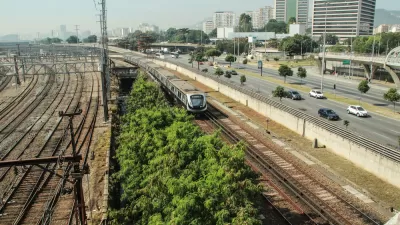Diana Lind previews the 2012 Earth Summit being held in 100 days in Rio, and argues why one of the year's most significant climate change conferences should receive more attention.
The countdown to Rio de Janeiro's 2012 Earth Summit begins today, or at least it would, if it was on your radar. With 100 days left, environmentalists and urbanists should take notice of the international conference where major non-governmental organizations will meet to take on environmental issues impacting the globe, argues Lind.
Occurring every ten years, the summit has produced significant initiatives and agreements meant to tackle worldwide environmental challenges. "In 1992, at the last summit held in Rio, more than 170 countries and 2,400 NGO representatives convened to discuss issues of biodiversity, deforestation, public transportation, oceans and other environmental topics. That event is probably best known for producing Agenda 21; it set forward a plan to avoid environmental degradation by protecting resources and settling the tab between carbon-intensive "global north" countries and the considerably greener "global south."
Lind explains that there are several reasons for urbanists to pay attention this year. The conference will take on new agenda topics, concentrating on urbanization and its consequences, as well as promoting the green economy. It will also provide an avenue for other stakeholders to call for environmental action. "This means that mayors and urban policy NGOs have a chance to put forward their ideas for more sustainable development. Some larger NGOs, such as the Natural Resources Defense Council, have drafted serious and thorough propositions that the whole urban affairs community should think about."
Next American City will publish pieces relating to the conference every other week until it commences at the end of June.
FULL STORY: Why the Rio Earth Summit Should Matter to Urbanists

Alabama: Trump Terminates Settlements for Black Communities Harmed By Raw Sewage
Trump deemed the landmark civil rights agreement “illegal DEI and environmental justice policy.”

Study: Maui’s Plan to Convert Vacation Rentals to Long-Term Housing Could Cause Nearly $1 Billion Economic Loss
The plan would reduce visitor accommodation by 25% resulting in 1,900 jobs lost.

Planetizen Federal Action Tracker
A weekly monitor of how Trump’s orders and actions are impacting planners and planning in America.

Waymo Gets Permission to Map SF’s Market Street
If allowed to operate on the traffic-restricted street, Waymo’s autonomous taxis would have a leg up over ride-hailing competitors — and counter the city’s efforts to grow bike and pedestrian on the thoroughfare.

Parklet Symposium Highlights the Success of Shared Spaces
Parklets got a boost during the Covid-19 pandemic, when the concept was translated to outdoor dining programs that offered restaurants a lifeline during the shutdown.

Federal Homelessness Agency Places Entire Staff on Leave
The U.S. Interagency Council on Homelessness is the only federal agency dedicated to preventing and ending homelessness.
Urban Design for Planners 1: Software Tools
This six-course series explores essential urban design concepts using open source software and equips planners with the tools they need to participate fully in the urban design process.
Planning for Universal Design
Learn the tools for implementing Universal Design in planning regulations.
Caltrans
Smith Gee Studio
Institute for Housing and Urban Development Studies (IHS)
City of Grandview
Harvard GSD Executive Education
Toledo-Lucas County Plan Commissions
Salt Lake City
NYU Wagner Graduate School of Public Service




























